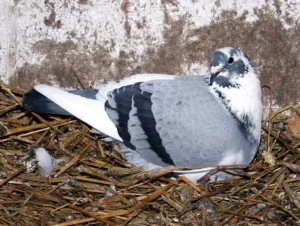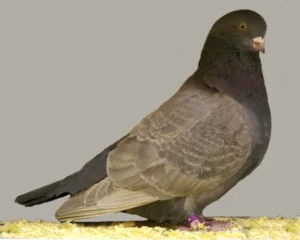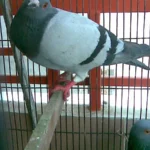Pigeons are more than “just birds.” They are known to be smart, fly high, and fly for a prolonged time. Tippler pigeons are one such fascinating pigeon type. So, let’s learn about them.
| Breed name | Tippler |
| Breed class | Medium |
| Special features | Endurance flying |
| Flying ability | Excellent |
| Purpose | Flying show; exhibition |
| Descendants of | A cross between the French Cumulet and homing pigeon |
| Size | Medium |
| Eye colors | White to pearly |
| Colors | Yellow-red to black-hues |
| Beak | Long |
| Neck | Short |
| Chest | Muscular |
| Can be kept as pets | Yes |
| Origin | Uncertain |
| Longest flying hours | 22 hours (non-stop) |
| Climat tolerance | All Climate |
| Rarity | Common |
We will go into more detail about tippler pigeons and their associated facts below.
What is a tippler pigeon?
The name “tippler” may seem cute and delicate. But tippler pigeons are not that sort of. Instead, these are one of the most enduring pigeon types out there.
The tippler pigeon is a domestic breed of pigeon that was created by crossing homing pigeon (Indian Highflyers/Tumblers) breed and the Cumulate. Just as racing pigeons are known for flying fast between two points, tippler pigeons are known to fly longer. These pigeons are bred and trained for endurance shows.
Tippler pigeons’ origins are unknown. However, some breeds are native to the Middle East, while others are thought to have evolved in the north of England. Tipplers were crossed to strengthen the bird’s fortitude and extend its flight range.

Fun Fact: Tippler pigeons have a long range of flight. Tippler pigeons have been known to fly for as long as 22 hours nonstop.
Tippler pigeon types
There are different tippler pigeons available. And depending on their types, their appearance varies. Here is a list of different types of tippler pigeons.
Gordon Hughes Tipplers
These tippler pigeons got their name from Gordon Hughes, who bred them in Derby, England. Gordon Hughes. Or simple Hughes Types are bred for endurance shows and can fly for over 19 hours multiple times.
Jack Boden Tipplers
Bred in Handforth, England, these tippler pigeons are bred by Jack Boden to take part in endurance competitions. These birds have reportedly flown for more than 20 hours numerous times.
Sheffield Tipplers
These tipplers are bred in Sheffield and hence the name. Sheffield Tipplers are also known as Sheffield Types and are known to fly for over 20 hours.
Macclesfield Tippler
These tipplers are short-faced, short-legged, and broad-shouldered pigeons commonly found in North England. Macclesfield Tipplers are renowned for flying really high and for long hours.
There are other categories in addition to tipplers. Their classifications are as follows.
- Lovatt Tipplers
- Meredith Tipplers
- Irish Blue Tipplers
- Manchester Tipplers
How to identify tippler pigeons?
Those unfamiliar with the tippler breed may have difficulty identifying these pigeons. But don’t worry; we’ve compiled a list of characteristics that will assist you in identifying tippler pigeons.
Sizes and Colors
Tippler pigeons are medium. Their coat colors, however, differ depending on their species. Gordin Hughes tipplers, for example, have grey and blue or blue with white feathers, whereas Jack Goden tipplers have blue, greys, sandy brown, and white feathers.
Head Shape
Round head in proportion to the body.
Eyes
No specific eye color is mandatory for tipper pigeons. But their eyes remain darker for 6 weeks after birth, which then subsequently turn lighter. Adult tipplers’ eye colors vary from white to pearly.
Beak
Even though it is not particularly significant for tippler pigeons, one can still notice a somewhat long beak in these birds. Their beak is firmly attached to their robust heads.
Neck
Tippler pigeons typically have a short necks.
Nostrils
They have noticeable, protruding nostrils.
Wings
Tippler pigeons depend heavily on their wings because they are the only birds that can fly for extended periods. That said, tippler pigeons have powerful wings tightly pushed to their body.
How to feed tippler pigeons?
Typically, white millet, barley, red milo, trapper peas, and linseeds can be used to feed tippler pigeons. You can also feed other seeds like flax, hemp, and safflower in smaller amounts.
Pigeons shouldn’t typically be fed an all-seed diet. Giving these birds a combination of grains and seeds is always preferable. The grains we mentioned above give these birds the energy to fly for a long time without making them fat.
Additionally, ensure the training tippler pigeons’ diet contains the appropriate amount of protein and carbohydrates. It will enable these pigeons to fly farther and faster during the competition.
Also, it should be noted that tipplers need to be fed at dusk (it is a better option). One can feed these birds two to three spoons of gran mixture and offer some water enriched in vitamins after a few minutes of the meal.
DO NOT OVERFEED your tipplers, or else they will get heavier and won’t be able to fly.
The purpose of training tippler pigeons

Tippler pigeons are trained to compete in endurance competitions because they are renowned for flying for a long time. The birds are trained to remain in the air until their owner instructs them to fly down.
A significant portion of training involves teaching the birds to land on cue rather than on their own initiative. Landing these birds at the right moment and location in competitions is also crucial. Thus, the training is absolutely essential.
These birds are taught to remain in the vicinity of their lofts and compete with other kits (a group of at least three pigeons), performing the same actions in other locations.
How to train a tippler pigeon?
Tipplers are trained or raised to fly for long. But the question is how are they trained? Or, what is the right way to train them? Let’s find out.
The following steps are typically taken while training tippler pigeons.
Start Early
It is always best to begin training your tippler kits (a group of a minimum of 3 pigeons) when they are 4 weeks old.
The Initial Command
The fancier should take the lead in this situation, and the associated feeding time signals may be helpful. A whistle, a food tray of a certain color, or feeding the droppers first and then allowing the tipplers to eat are just a few of the fancier signals that can be used. Let the tipplers connect the signals to the loft feeding period. You can begin training the pigeons to land on the roof at your command once they become accustomed to this command.
Train them to fly
Tipplers have an innate ability to fly for long. Despite their eagerness to fly, young tipplers have poor navigational skills. They might become lost in the process as a result. So, depending on the weather, begin with 5-8 hours per week. This can be extended to six hours, which is the ideal amount of time for training.
Train them to land on command
When called, the tipplers must land on the loft’s roof. Utilize the signals in addition to the feed, as we mentioned above, to help the pigeons understand your command to land on the loft roof. Here, you can also use droppers, as we mentioned above. Feeding the droppers will stimulate the tipplers to land and eat. The initial establishment of this association might be challenging, but ongoing practice will ease the process.
Using the Bait
The droppers (birds) are nothing but baits for the tipplers. Droppers can be used as signals for tipplers to land. They can also be taken as visual commands for tippler pigeons when they are called to fly down. However, the fancier needs to train the tipplers to establish the relationship between the droppers and the signal or command they stand for.
Training at Night
It is essential to train tipplers at night or dusk. Lighting the area where you want your tippers to land with weatherproof lights is important. Use the dropper feeding system under the artificial light to encourage the tipplers to land on the loft roof as soon as the nighttime training is introduced. They can be trained to fly for up to 8 hours, including in the dark, once they become accustomed to flying in the dark.
The Food
Some experts also believe training your birds when hungry is better. It will ensure that the birds respond promptly when given droppers.
Why won’t sometimes tippler pigeons fly?

An injury or damage to the wings is one of the main causes of your tipper’s refusal to fly. So, if you discover any kind of illness in your bird, call your vet immediately.
Some other reasons that may restrict your bird to fly include the following.
- Fatigue
- Hunger
- Stress
- Shyness
- Illness
Differences between homers and tipplers
Size is the biggest difference between homers and tipplers. Homer pigeons tend to be longer and bigger, whereas tippler pigeons are leaner and smaller.
Summary
This concludes our discussion of the traits of tippler pigeons. These incredible birds have astounding endurance while flying. We sincerely hope that this post has helped you learn more in-depth information about these flying marvels of nature.



